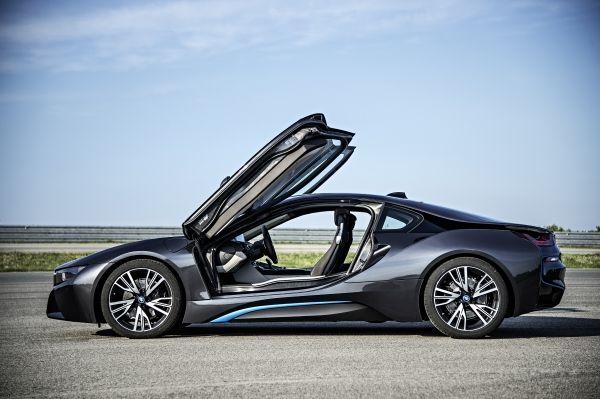
The highly anticipated BMW i8 plug-in hybrid electric car is entering production in April, with customer deliveries beginning in June. It will be available on the European market first and is sure to make a splash, with this highly differentiated plug-in hybrid.
i8 vehicle specs
The complete specs of the car that were recently released were more impressive than initial estimates, with fuel consumption of 112 mpg for this plug-in hybrid, helping to strategically position the i8 for commercial success. The electricity consumption was rated at 19.1 kWh per 100 miles, an impressive figure for a sports car. It can go 62 mph in 4.4 seconds and reaches a top speed of 155 mph (electronically limited).
As a plug-in hybrid it has an all electric range of 23 miles from the 7.1 kw battery, which can be charged 80 percent in less than two hours using a 230-volt socket. The combustion engine is activated when the battery drops below a specified minimum or at high speeds.
Lightweight materials
The i8 and its cheaper cousin, the i3, both make extensive use of carbon fiber -- a composite material that is lighter than steel and aluminum but has similar strength to steel and can withstand high stress. Amory Lovins has been urging the auto industry to utilize carbon fiber materials for years, touting their ability to reduce fuel consumption due to their light weight, while boosting safety, but the cost is currently high, thus it is primarily used in niche markets. Because of extensive use of carbon fiber and aluminum, the BMW i8 weighs only 3,274 pounds.
Hybrid electric vehicle powertrain
The i8 is an all-wheel drive vehicle, with a motor for each axle. There is a 131-horsepower electric motor powering the front wheels. On the rear axle, there's a 1.5-liter, 3-cylinder turbocharged unit making 231 HP. The two motors combined make 362 HP. When the car drives in the zero-emission all-electric mode, the front motor powers the car, thus becoming a front-wheel drive vehicle. It can then achieve tops speeds of 75 mph.
BMW says demand for the $136,625 sports car has been strong, but have disclosed few details. "Demand for the BMW i8 is already exceeding the planned production volume during ramp-up," BMW said in a statement. BMW and Tesla are proving there is a demand for high-performance electric vehicles.
The BMW i8 has certainly attracted a lot of attention, which is typical of high-performance dream cars, but this car has earned the attention. In the end however, does the i8 help advance the electrification of cars or make the industry more sustainable?
Greener cars
The quicker that the price of carbon fiber falls, the better. Ramping up production and use of this material will lead to falling prices and more widespread use. Its introduction into the luxury car market will likely help it spread into more widespread use, which can have a significant impact on fuel economy.
BMW is considered one of the more sustainable automakers, and the BMW i8 also draws a lot of attention and keeps electrified vehicles on our minds, even if it is outside of our price range.
http://www.youtube.com/watch?v=lV3DmhubghQ
Image credit: BMW Group
Related Posts:
Toyota Testing Wireless Charging Technology for Electric Cars
BMW i3 Offers a Simple Cure for EV Range Anxiety
Sarah Lozanova is a regular contributor to environmental and energy publications and websites, including Mother Earth Living, Green Building & Design, Triple Pundit, Urban Farm, and Solar Today. Her experience includes work with small-scale solar energy installations and utility-scale wind farms. She earned an MBA in sustainable management from the Presidio Graduate School and she resides in Belfast Cohousing & Ecovillage in Midcoast Maine with her husband and two children.

Sarah Lozanova is an environmental journalist and copywriter and has worked as a consultant to help large corporations become more sustainable. She is the author of Humane Home: Easy Steps for Sustainable & Green Living, and her renewable energy experience includes residential and commercial solar energy installations. She teaches green business classes to graduate students at Unity College and holds an MBA in sustainable management from the Presidio Graduate School.














